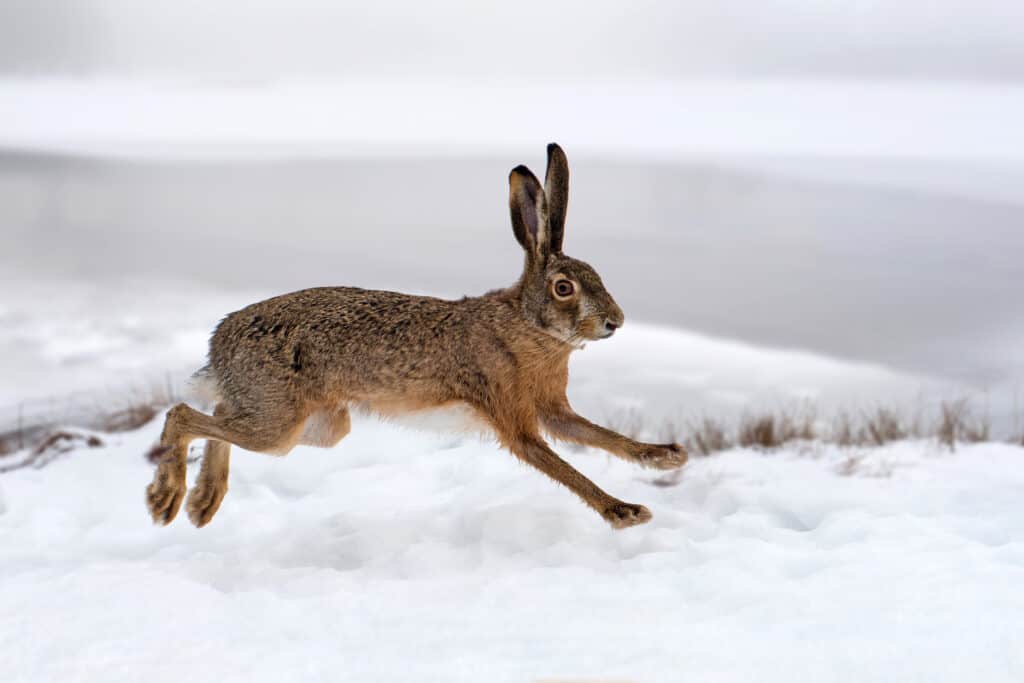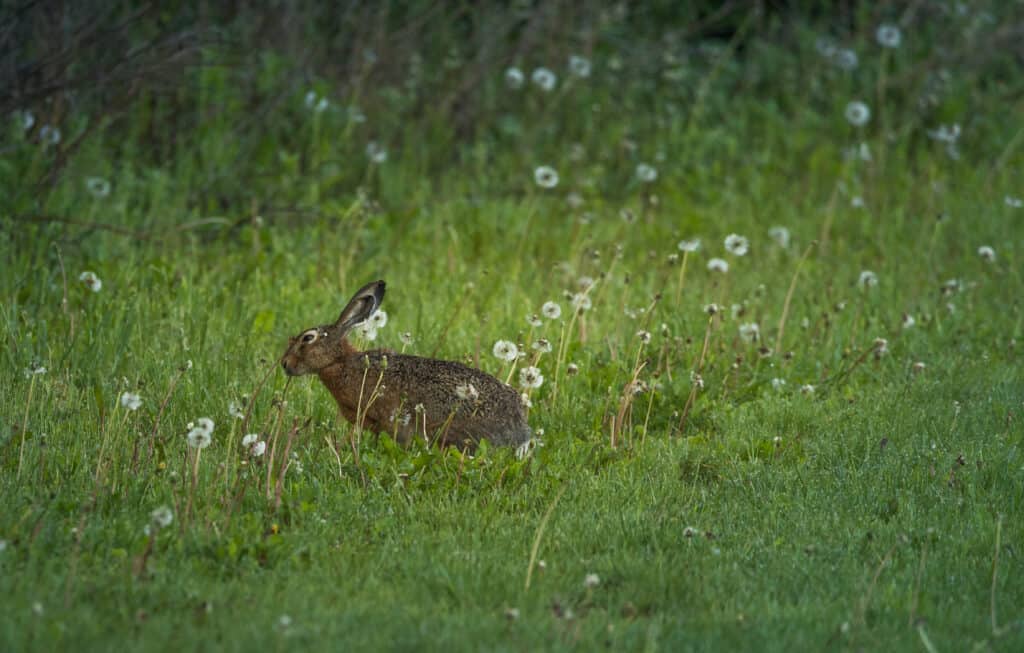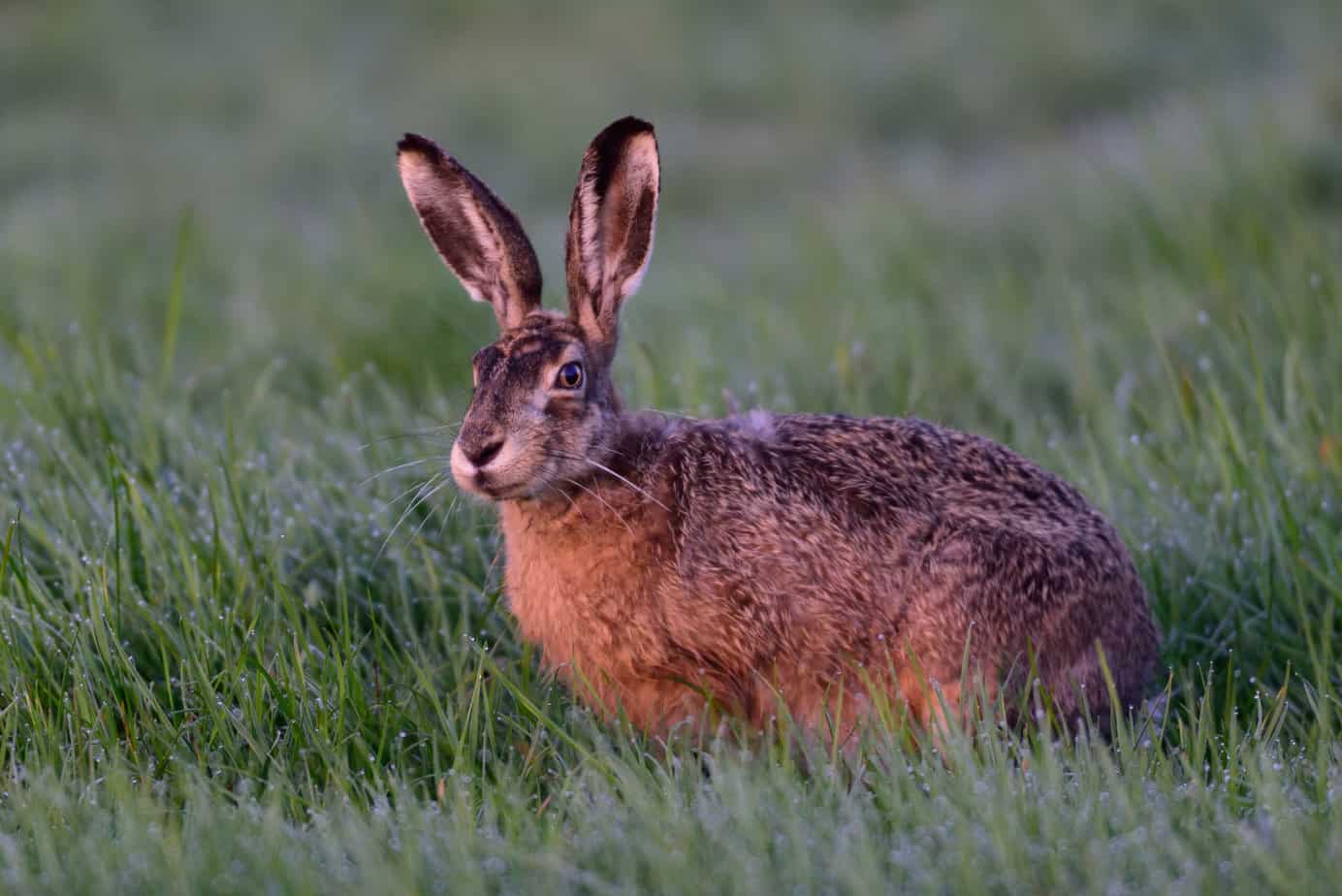As a seasoned rabbit hunter, I know that choosing the right time of day to hunt rabbits can make all the difference in success or disappointment. Rabbits are known to be most active during certain hours, which makes the prospect of hunting them more enjoyable and fruitful. In this article, I’ll share my insights on the best time of day to hunt rabbits.
Rabbits are crepuscular creatures, meaning they are most active at dawn and dusk. During these low-light hours, rabbits feel more protected from predators and venture out in search of food. This is an ideal time for hunters to be out in the field, as rabbits are more likely to be on the move. However, if hunting with dogs, rabbits can often be found throughout the day. It’s important to consider factors such as local regulations, temperature, and weather conditions, as they can also impact the best time to hunt rabbits.
The Best Time of Day to Hunt Rabbits
Dawn
In my experience, the early morning hours are one of the best times to hunt rabbits. During dawn, rabbits tend to be more active as they venture out to forage for food. The low light conditions during this time make it slightly more challenging for both the rabbits and hunters, adding an element of excitement to the hunt. Additionally, the cooler morning temperatures can make it more comfortable to explore the outdoors.
When hunting rabbits at dawn, it’s essential to pay attention to the weather conditions. Overcast or drizzly mornings can increase rabbit activity, as they are more likely to seek shelter and will be out feeding. On clear mornings, rabbits might be more cautious and reluctant to venture too far from their burrows.
Here are some tips for hunting rabbits at dawn:
- Arrive at your hunting spot before sunrise to allow time for preparation and observation.
- Pay attention to the weather conditions, as they can greatly affect rabbit behavior.
- Look for rabbit tracks, particularly in areas with moist soil or dewy grass.
Dusk
Evening hours are also a prime time to hunt rabbits. Like dawn, dusk provides low light conditions which make rabbits more active and contribute to the challenge of the hunt. During the evening, rabbits tend to move from their daytime resting spots to feeding areas, offering potential opportunities for a successful hunt.
When hunting at dusk, it’s again important to consider weather conditions. Cooler evenings might encourage more rabbit activity, while warmer evenings could cause them to be less active.
Here are some tips for hunting rabbits at dusk:
- Arrive at your hunting spot at least an hour before sunset to allow time for scouting and preparation.
- Target areas where rabbits are likely to feed, such as along the edges of fields or near brushy cover.
- Be patient and quiet, as rabbits are more likely to emerge from their hiding spots if they feel safe and undisturbed.
In summary, both dawn and dusk are prime times for hunting rabbits, as these periods of low light correspond with increased rabbit activity. Be mindful of weather conditions during these times, as they can greatly affect rabbit behavior. Ultimately, finding the ideal time of day for hunting rabbits will depend on your personal preference and ability to adapt to changing conditions.
Rabbit Species and Habitats
As an avid rabbit hunter, I’ve encountered various rabbit species in different habitats. Let me share some information about the most common rabbit species and their preferred environments.
Cottontail rabbits are the most common rabbit species in North America. They favor habitats like grasslands, fields, and thickets where they can easily move around and find shelter. These rabbits are known for their short, fluffy tails that resemble a cotton ball. In their habitats, they often feed on grasses, weeds, and other forbs.
Swamp rabbits are usually found in the southeastern United States, particularly in wetlands and swamps. They are agile swimmers, perfect for navigating their water-filled habitats. These rabbits feed on a variety of vegetation, including grasses and aquatic plants.
Jackrabbits, on the other hand, are not true rabbits but belong to the hare family. They are usually found in the western United States in open habitats like deserts and prairies. Jackrabbits have long legs and ears, which help them adapt to their surroundings. They usually feed on shrubs and cacti.
Rabbit habitats typically offer shelter, food, and protection for these animals. Some common features of their habitats include:
- Grasses: Rabbits primarily feed on grasses, which provide both nutrition and cover for them.
- Brush piles: These provide ideal hiding spots and protection from predators.
- Hollow logs: Rabbits might use hollow logs as shelter during harsh weather or as a safe space to raise their young.
- Timber: Forested areas with dense understory provide excellent cover and protection for rabbits, as well as ample food sources.
Understanding the various rabbit species and their habitats is crucial for hunters seeking success in their rabbit hunting pursuits.
Hunting Techniques and Tools
Hunting with Dogs
When I hunt rabbits, I rarely utilize the help of dogs. It’s just not that popular in my area. However, hunting dogs, particularly beagles, are well-suited for rabbit hunting due to their keen sense of smell and high energy levels. As a team, the hunter and dogs work together to locate the rabbits by allowing the dogs to track the scent of rabbits through the field. Once the dogs have spotted a rabbit, their barking helps the hunter determine the location so they can position themselves for a shot. It’s important to keep in mind the wind direction when hunting with dogs, as it can affect their ability to track the scent.
Shooting Lanes
In my experience, finding the perfect shooting lanes is essential for successful rabbit hunting. To create suitable shooting lanes, I scan the area for dense cover, such as thickets and brush piles, where rabbits are likely to hide. I often find high ground along creeks, swamps, and brambles as ideal spots for setting up my shooting lanes. To increase my chances of hitting a rabbit, I typically use a classic rifle like a .22 caliber or a 20-gauge shotgun. Of course, it’s vital to follow local regulations and only hunt during the legal rabbit hunting season.
Snares
Snares can be an effective method for rabbit hunting, especially if I want a more hands-off approach. To use this technique, I first look for signs of rabbit activity, such as tracks and droppings, along their pathways. Once I’ve identified a path, I set up a snare using a thin wire or cord. The snare should be positioned at the right height and width to capture a rabbit without harming it. Some essential safety precautions I follow when using snares include:
- Wearing gloves to prevent leaving my scent on the snare
- Checking the snares regularly to avoid causing suffering to caught rabbits
- Storing and handling rabbits carefully to minimize the risk of tularemia, a bacterial disease
By employing these tools and techniques, I can maximize my chances of successful rabbit hunting while ensuring a more enjoyable and responsible experience.
Seasons and Weather Factors

When I head out to hunt rabbits, I always consider the seasons and weather factors, as they can have a significant impact on rabbit activity and hunting success.
In terms of seasons, rabbit hunting typically takes place from mid-November to the end of February. During the early season, there may be a greater abundance of rabbits, but many hunters, including myself, prefer to wait for the first good snow cover. Snow makes it much easier to follow rabbit tracks and increases the visibility of these elusive creatures.
Temperature also plays a critical role in rabbit activity. I find that rabbits tend to be more active when the weather is cooler, such as early morning or evening. The cooler temperatures allow rabbits to expend less energy while foraging, making these times ideal for hunting.
The weather forecast is another important factor that I take into account when planning my rabbit hunting trips. Rain or snow can have a significant impact on rabbit activity and their preferred locations. For instance, rabbits may seek shelter in denser cover during wet or snowy conditions.
Hunting pressure is something I always consider when choosing where and when to hunt rabbits. If an area experiences heavy hunting pressure, it may cause rabbits to be more skittish or change their patterns. Therefore, I try to hunt in locations with lower hunting pressure to increase my chances of success.
Lastly, snow cover is an essential factor to consider when hunting rabbits. As mentioned earlier, snow helps with tracking and visibility. However, deep snow may hinder my ability to move quietly or quickly through the terrain, so I try to find a balance between having enough snow for tracking purposes and not having too much to negatively impact my hunting experience.
Attracting Rabbits to Hunt
When I want to attract rabbits to hunt, I keep in mind their love for certain foods. At the top of the list are carrots, lettuce, and clovers. Adding apples, corn, and cabbage will also help create an irresistible buffet for rabbits.
Rabbits, being crepuscular animals, are most active during the early morning and evening hours of the day. During this time, I strategically place their favorite foods in specific areas where I can easily observe the rabbits. This will not only draw them in, but it will also increase my chances of a successful hunt.
Here are some useful tips I follow to effectively attract rabbits:
- Plant patches of clover and other rabbit-attracting plants around my hunting area to create a natural food source.
- Strategically place carrots, apples, corn, and cabbage in visible locations, ensuring they are not too close to my hideout.
- Observe the rabbits over a period of days to understand their feeding patterns and preferred locations within the hunting area.
Remember, attracting rabbits takes patience and attention to detail. By understanding their preferences and habits, I can make the hunt more enjoyable and successful.
Safety and Preparations

Before heading out for a rabbit hunting expedition, it’s essential to take safety and preparation seriously. I always make sure to check local regulations and be aware of habitat loss that might affect rabbit populations, as well as keeping an eye on the increasing presence of whitetail deer in some areas.
Wearing proper attire is key for any hunting trip. For me, that means donning a sturdy pair of hunting boots, as the terrain can often be uneven and thick with underbrush. A good pair of gloves is also crucial—rabbit habitat is frequently rife with thorny brush, and protecting my hands from injuries makes the experience much more enjoyable.
When it comes to the actual hunting, patience is one of my most valuable assets. Rabbits are well-adapted to their environment and can be elusive prey. That’s why it’s important to be patient, observe their habits, and choose the optimal time to strike.
Here’s a quick rundown of the essential preparations:
- Check local regulations: Be aware of laws, permits, and hunting seasons in your area.
- Prepare for habitat loss: Keep in mind the changing rabbit populations and competition with other species like whitetail deer.
- Wear hunting boots: Ensure good footing with a reliable pair of boots.
- Bring gloves: Protect your hands from thickets and thorny brush.
- Embrace patience: Take your time and study rabbit habits for a more successful hunting experience.
In summary, being properly prepared and placing safety at the forefront are key to a successful and enjoyable rabbit hunting experience. By wearing the right gear, being patient, and staying informed about the local rabbit population, I’m better equipped to have a successful day out in the field.
Processing and Cooking Rabbit Meat
When I hunt rabbits, the first step after a successful hunt is processing the meat. To do this, I make sure to wear gloves and carefully skin the rabbit, being mindful of not cutting too deep into the meat. After removing the skin, I separate the meat from the bones and package it for storage, freezing, or immediate cooking.
Rabbit meat is quite versatile and can be cooked in various ways. One of my favorite methods is to simply cook the rabbit in a crock pot with water and a little bit of salt. This allows for the meat to be used in several dishes, as it gives about 1.25-1.5 lbs of shredded rabbit meat per animal.
For a more elaborate meal, I like to prepare a rabbit stew as follows:
- Place vegetables (such as carrots, onions, and celery) in the bottom of a cast-iron Dutch oven
- Top with rabbit meat
- Sprinkle seasoning (such as Allegro) over the top of the rabbit and vegetables
- Pour 2 cups of broth over the mixture
- Add thyme sprigs
- Cover the pot with a lid and bring the dish to a slight boil over medium heat, then reduce heat and let it simmer for 2 to 3 hours, or until the rabbit meat is tender
Alternatively, frying rabbit is another tasty option. If you know how to fry chicken, you’ll find it quite easy to prepare delicious fried rabbit. Just make sure to always cook the meat to 160 degrees for safety reasons.
As a helpful tip, when choosing which rabbit to cook, consider the age and size. Fryer or young rabbits are typically less than 12 weeks old and weigh between 1.5 to 3.5 pounds, while mature rabbits, known as roasters, are above this age and weight. The meat from younger rabbits can be cooked in the same way as poultry, while mature rabbit meat can be a bit tougher and might require a slower cooking method like stewing or braising.
So there you have it, some insights into processing and cooking rabbit meat. Enjoy your next rabbit meal, knowing that you’ve prepared it safely and deliciously!
Conclusion
From my experience and research, I’ve found that the ideal time for hunting rabbits is during the early morning or late afternoon hours. This is because rabbits are most active during these times, as they venture out to feed while the low light provides them some protection from predators.
When hunting rabbits, it’s important to take note of their feeding patterns and habitat preferences. In the winter, they may be more active during the day due to the colder temperatures. Remember to be patient and stay alert, as rabbits can be quite elusive.
In summary, focusing on early morning or late afternoon hours for rabbit hunting will increase your chances of success. Be sure to pay attention to the specific needs and habits of rabbits in your area, and always hunt responsibly and ethically. Happy hunting!

